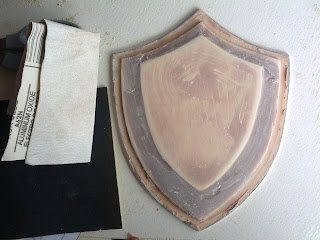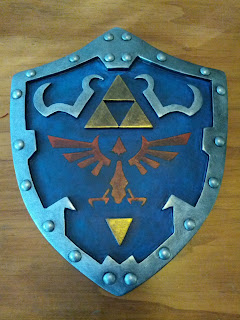The shield itself is about 25cm tall (10") and 12mm thick, though naturally you can choose to just enlarge each element to suit the size you want to make it. This project is great as it requires only a few different elements, so if you haven't done anything like this before this is a pretty good place to start.
When all the pieces are cut you can glue them together. Be sure that you clamp them together or put some weight on them as they dry to ensure uniformity of adhesion. For glue I used epoxy filler as it's strong, quick to dry and durable.
Once the shield is smooth and shaped as you like it you can glue on the 'metal' detailing. Some of the pieces will need to bend to the shape of the shield, so you'll need to clamp them. Depending on the size of the shield you can use clothesline pegs (as I have), bulldog clips or builders clamps to do this. Be sure to leave it to dry overnight when doing this as the wood will naturally want to pull away, resulting in much cursing and stomping of feet.
Once all glued in place I decided to smooth off the joins to make it look like one solid edge, again using several layers of filler and a lot of sanding.
A thin undercoat layer will reveal the texture of the surface, and at this stage you can add/change detail as you please. I want the centre of the shield to have a ripple like texture when finished, so I used a rotary tool to roughen the surface.
You can use any number of different objects for the rivets. I found some great buttons that were perfectly sized for this project at my local sewing store, and simply smoothed off the back of each one and them glued them in place.
Now for the final details to be glued in place. Before undercoating again be sure to leave the shield to dry properly.
I applied 6 coats of undercoat, to ensure consistency and a final layer of smoothing (as consistent layers of paint fill small cracks/scratches).
After the 6 base coats I applied a single coat of Citadel black as it makes for a perfect painting surface, and is much flatter (less reflective) than other matt black paints that I've used.
I painted all the raised parts first (basically all the metallic elements) and then stippled 5 layers of blended blue, turquoise, and white to the face of the shield. Finally, I used two wash coats (seen still wet in the image below) of blue and black to give depth and consistency to the stippled layers.
Once dry it was ready for the crest. I used a fine black felt tip pen to draw the outline. I did it freehand as I like small differences in handmade items, but if you prefer you can use a stencil (I'd recommend it).
Once outlined the crest is filled with two layers of black.
Then two layers of patchy crimson.
Then, to highlight and define the crest, two layers of blood red (the final blended with a little white).
Finally, a thick coat of clear lacquer is applied to the face of the shield and then oven baked for an hour on low heat. This gives the crest and blue background a lot of depth and colour and, in my humble opinion, looks fantastic. If you haven't worked with paint/wood/lacquer much before I wouldn't recommend this method, you're much better to paint on several thin layers of lacquer and let them dry normally. If you do want to oven bake the finish be sure you keep a close eye on it, place the shield on baking paper, keep the temperature low, turn on an exhaust/ceiling fan, open the windows and keep the oven door open 1/4 for ventilation. You can very, very easily make the paint blister or set fire to something so be careful and keep a close eye on it.
What you'll need
2.8mm Plyboard - You'll need around 1000mm x 250mm to make a shield of this size.
Epoxy Filler - The higher the quality, the better. I used around 100-120 grams in this project.
Buttons - These form the bold rivets located around the steel edge of the shield.
Water Based Paint - Because of the limited colour palette I only needed 9 colours. There are many brands to choose from but I use Citadel miniature paints as I've had a lot of experience with them and find them to be equal or better than any other product on the market.
Clear Gloss Lacquer - This is optional but will give the colour on the shield a much deeper hue with a reflective finish, in addition to protecting it. It also serves to divide the metal and decorative elements on the front of the shield, which in my view really adds depth and character.
Sandpaper - I used quite a bit, two squares each of 30cm square 120/240 grit.
Jigsaw and Rotary Tool - As they are both power tools ensure that you observe the correct safety wear.
Starting off
Note: If you want a curved shield backing you can, without too much trouble, set up a form, glue the sheets together and clamp to suit. If you want to have some real fun you can make your own steam box and steam bend your wood, which is great on larger projects, but if you haven't had much woodwork experience I wouldn't recommend it. In any case here is a good resource on bending methods if that's what you'd like to do. An easy way to approximate the curve you want is to use a deck of cards and, looking side on, you can simulate each layer and change it quickly and easily to suit. When it's as you like simply take a measurement and cut your layer of ply to suit.
First of all you need to trace and cut out the separate layers of the shield. For a shield this size I've used three layers of plywood, though for larger projects you can use more layers as you see fit. Where the curve in the shield is will depend on how large you cut each layer.
When all the pieces are cut you can glue them together. Be sure that you clamp them together or put some weight on them as they dry to ensure uniformity of adhesion. For glue I used epoxy filler as it's strong, quick to dry and durable.
Once glued together use filler to smooth the steps between each layer, then sand. Repeat this until the finish is perfect (I used 3 layers). Try not to put too much on in a single layer; it's better to use multiple thin layers that are each sanded and shaped. Also make sure that each layer is left to cure fully before sanding and finishing.
Once the shield is smooth and shaped as you like it you can glue on the 'metal' detailing. Some of the pieces will need to bend to the shape of the shield, so you'll need to clamp them. Depending on the size of the shield you can use clothesline pegs (as I have), bulldog clips or builders clamps to do this. Be sure to leave it to dry overnight when doing this as the wood will naturally want to pull away, resulting in much cursing and stomping of feet.
A thin undercoat layer will reveal the texture of the surface, and at this stage you can add/change detail as you please. I want the centre of the shield to have a ripple like texture when finished, so I used a rotary tool to roughen the surface.
You can use any number of different objects for the rivets. I found some great buttons that were perfectly sized for this project at my local sewing store, and simply smoothed off the back of each one and them glued them in place.
Now for the final details to be glued in place. Before undercoating again be sure to leave the shield to dry properly.
I applied 6 coats of undercoat, to ensure consistency and a final layer of smoothing (as consistent layers of paint fill small cracks/scratches).
After the 6 base coats I applied a single coat of Citadel black as it makes for a perfect painting surface, and is much flatter (less reflective) than other matt black paints that I've used.
I painted all the raised parts first (basically all the metallic elements) and then stippled 5 layers of blended blue, turquoise, and white to the face of the shield. Finally, I used two wash coats (seen still wet in the image below) of blue and black to give depth and consistency to the stippled layers.
Once dry it was ready for the crest. I used a fine black felt tip pen to draw the outline. I did it freehand as I like small differences in handmade items, but if you prefer you can use a stencil (I'd recommend it).
Once outlined the crest is filled with two layers of black.
Then two layers of patchy crimson.
Then, to highlight and define the crest, two layers of blood red (the final blended with a little white).
Finally, a thick coat of clear lacquer is applied to the face of the shield and then oven baked for an hour on low heat. This gives the crest and blue background a lot of depth and colour and, in my humble opinion, looks fantastic. If you haven't worked with paint/wood/lacquer much before I wouldn't recommend this method, you're much better to paint on several thin layers of lacquer and let them dry normally. If you do want to oven bake the finish be sure you keep a close eye on it, place the shield on baking paper, keep the temperature low, turn on an exhaust/ceiling fan, open the windows and keep the oven door open 1/4 for ventilation. You can very, very easily make the paint blister or set fire to something so be careful and keep a close eye on it.
The finished product, showing off its glossy finish.
In part two I'll show you how I made the back of the shield, added detail (a leather strap and handle) and the hardwood stand I made to display the shield.
=============
Thanks for reading! If you found this tutorial interesting, fun or something else entirely I recommend that you check out my other tutorials, like the Westeros Map (Game of Thrones) that I made recently or my Steampunk Nerf Guns.



























































